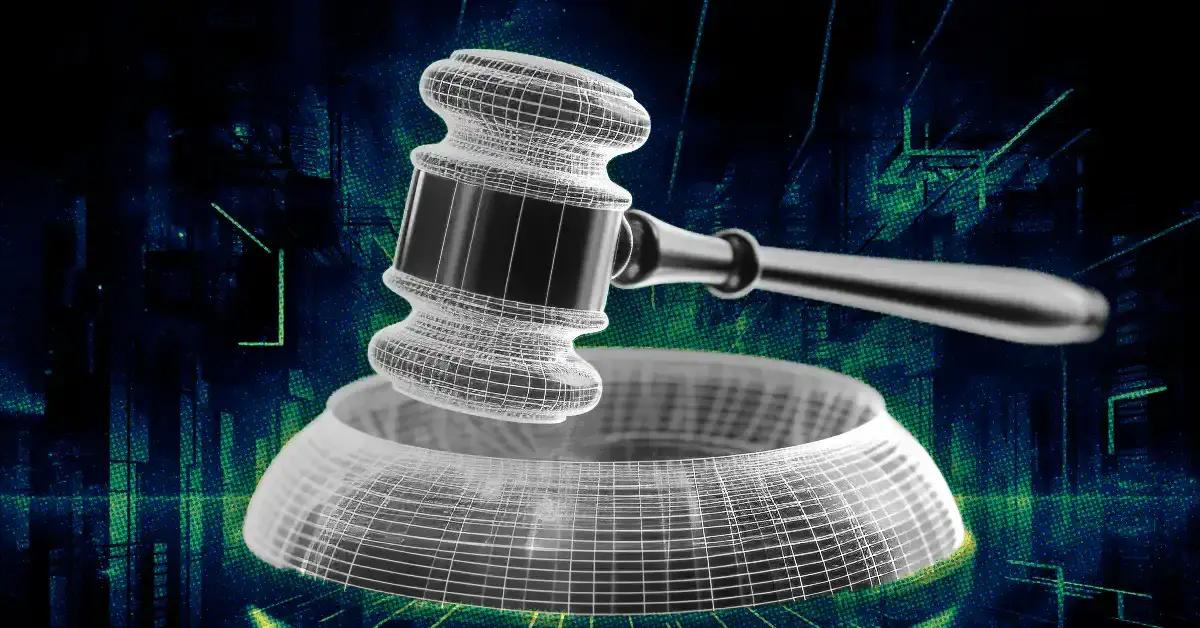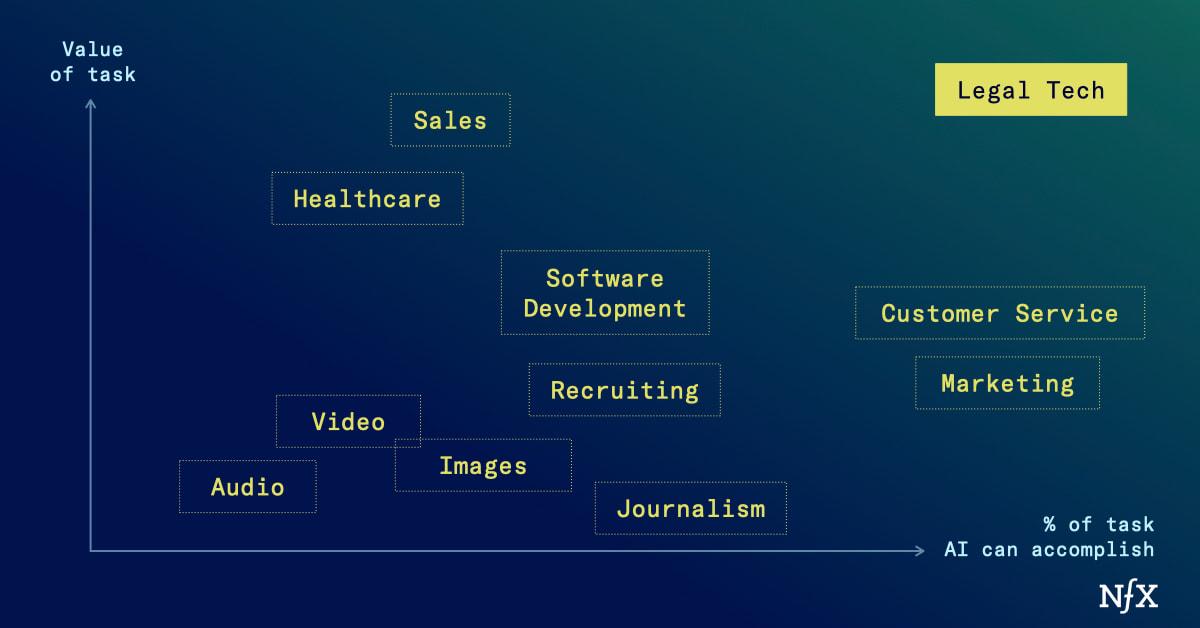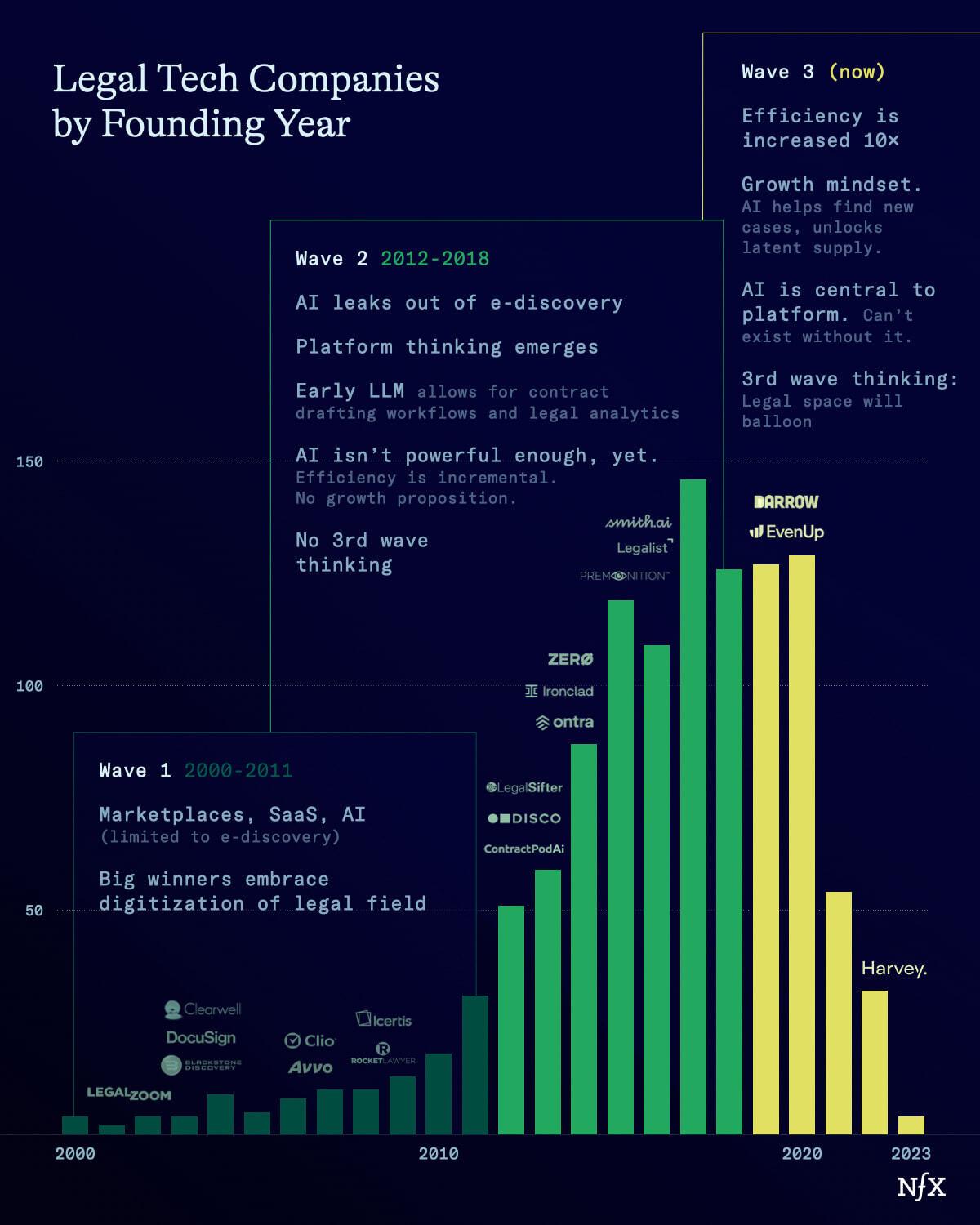

Legal Tech has not been the best sector for founders to spend time in over the last 20 years. But Legal x AI is different, and software in the legal sector has taken off.
We started investing in AI-powered Legal Tech several years ago, before the Generative AI boom. There are bigger patterns behind the explosive growth in this vertical, and reason to believe there’s much more value yet to come.
When we first invested in EvenUp, Darrow, ZERO Systems/Hercules, and others still in stealth, we saw three big differences from traditional Legal Tech.
First, AI x Legal helps lawyers make more money. Law firms that bring “AI inside” experience higher caseloads, more cases won, and faster claim processing.
Second, AI-powered software immediately and obviously improves the day-to-day experience of the lawyer using it. AI does tasks that lawyers traditionally find hard, tedious, or expensive – tasks that feel like eating glass.
Third, there were 10X leaps in workflows to save time, not the 1.5X offered by traditional Legal Tech. Counterintuitively, saving time is always a double edged sword with law firms, because their billable hours business model means they only make money when they take time, not save time.
Nevertheless, the 10X improvement in hours spent breaks them out of that incremental mindset that has been holding them back from embracing software. It helps them generate more revenue through more cases at higher value.
These benefits will repeat across many industries, not just legal. But it’s worth looking deeply at legal because it’s one of the first verticals to really take off with AI.
Why is legal leading the rollout of AI?
There are some industries that appear to be natural fits for AI disruption. It’s a matter of two variables: the percentage of a task that can be accomplished by AI, and the value of the task it can accomplish.


Now that we have LLMs that are exceptional at reading, writing, and analyzing, the business areas where they apply most are fields like law, customer service, software development, marketing, and sales.
The legal profession is built upon language data. The only product of legal is words. LLMs crack open language-based data the way that other forms of AI have been predicting patterns from numerical data. LLMs identify patterns in that language data and can offer up nearly complete products to lawyers and their clients.
That’s the same thing that great lawyers do. Language inference and generation based on years of study.
You can ask a great lawyer if a certain privacy policy is compliant, and the best can give you an answer instantly. At this point, so can an intelligent AI trained on a corpus of high quality legal data. You can ask a great lawyer to draft a contract, and they can do so in a matter of hours thanks to their analytical skills and intuition informed by past experiences. So can an LLM trained on a dataset of similar contracts.
But it goes beyond just that. AI doesn’t just replicate the skills of great lawyers. It improves them.
Evyatar Ben Artzi, the CEO of NFX portfolio company Darrow, points out that most litigators have a wealth of experience and finely trained instincts that allow them to excel. AI augments that natural talent.
One promise of AI in the legal field is the ability to incorporate a wider corpus of data, see patterns that human cognitive limitations and biases will overlook, and create more efficient legal processes.
AI is about to finally deliver on a promise that the legal field has been waiting for for years.
This is Actually the Third Wave of Legal Tech
There have been three waves of Legal Tech since 2000, with many of the companies trying to implement AI as part of the value proposition. The AI thinking was right, but the AI was never powerful enough. Now it is.


First Wave Examples: 2000-2011
- LegalZoom
- Docusign
- Blackstone Discovery
- Clearwell
- Avvo
- Clio
- Rocket Lawyer
- Icertis
The most successful of the first wave Legal Tech companies were traditional SaaS workflows like Docusign and Clio, or marketplaces like Avvo and LegalZoom. These companies were not particularly AI-centric.
However, a few companies in this first wave were already beginning to use AI to tackle legal problems, particularly with the e-discovery companies in the mid 2000s.
E-discovery is a process where electronic data is searched for use in legal cases. AI is used as a tool to search, rank, and categorize this data. An early example of this was Clearwell, which was used to search for concepts in documents rather than just keywords. The idea was to reduce the manpower needed to wade through troves of legal documents and save time.
A later example was Icertis, founded in 2009, to use early versions of artificial intelligence to read and analyze contracts. (Today Icertis is leaning into generative AI).
There were not many of these companies – between 2000 and 2010 there were fewer than 10 Legal Tech companies founded each year. The biggest winners like Docusign and LegalZoom weren’t AI companies, but were transformative for the profession, and democratized access to legal expertise, information, and documentation. The AI companies were more incremental. AI was seen as a better way to search, or a way to cut costs by 1.5x. It was a tool, not a way to unlock latent supply, or scale a business 10x.
Second Wave Examples: 2012-2020
-
- ContractPod AI
- DISCO
- Legal Sifter
- Ontra
- IronClad
- Legalist
- Premonition
- Leading Edge: ZEROSystems/Hercules
- Leading Edge: Smith.ai
In the second wave, AI began to spread out of e-discovery and into a variety of other workflows. They started thinking less like tools, and more like platforms.
Disco, for example, combined the tools of e-discovery with case management software.
Other companies learned more heavily into the contract process. They focused not just on contract drafting, but contract storage and analytics.
For example, Ontra is an AI-powered legal operating system for private markets. The company automates contract intake, negotiation and execution. It also can transform physical contracts into structured data, and compare and analyze contracts across an entire organization.
This wave was also powered by the emergence of early natural language processing which helped reduce friction within existing processes.
As The New York Times put it in 2017, LLMs “proved useful in scanning and predicting what documents will be relative to a case…yet other lawyer’s tasks like advising clients, writing legal briefs, negotiating and appearing in court seem beyond the reach of computerization, for a while.”
Many didn’t see what LLMs would eventually become – generative partners across a variety of specialized writing tasks. But the few companies that did have powered a transition toward the third wave (which we’re in now).
Smith.ai, for example, saw the potential for Natural Language Processing to improve lead qualification, intake, and outreach for law firms (among other high-value service businesses). The customer engagement platform known best for its virtual receptionists has built AI tools that improve both the experience and outcomes of conversations with clients. By equipping human agents with the right information at the right time based on the nature of the conversation, the AI elements ensure that prospects and clients receive a prompt and accurate response, and that data from those interactions is passed to key business programs, all while the attorneys complete billable work uninterrupted.
Agents, supported by AI, can navigate all of the nuances of potential client inquiries, regardless of the type of law or client. The idea of LLM-powered firms has arrived in wave 3 (today), but Smith.ai was one of the earliest companies to realize that AI can improve the efficiency and quality of work and provide a superior customer experience.
NFX Portfolio company ZERO Systems/Hercules is one of them. They began by creating secure email and mobile email products for law firms. Then they expanded. Now, they have AI applications across an enterprise, not just the legal departments: policy enforcement, document extraction, time capture, filing compliance, offboarding, etc., and have transitioned into wave 3: the maturation of industry-specific LLMs.
The Third Legal Tech Wave is LLM powered by AI, and this is the big one
- EvenUp
- Darrow
- Harvey
- ZERO Systems/Hercules
- Smith.ai
- …
The internet allowed wave 1’s big Legal Tech winners to see a world where the law was executed online. The winners in this third wave will see the future paved by LLMs and emerging generative AI technologies.
Here’s why we think that LLMs enable 3rd wave thinking in the Legal Tech space:
First: the AI technology finally does the work that needs to be done
“Language” is the core product of the legal industry. LLMs trained on corpuses of legal language now have language skills on par with a well trained lawyer.
Second: learning the new workflow is seamless.
Generative AI’s ability to draft full documents or surface new cases instantly, solves problems on day 1. There’s no software to learn. It’s instant gratification and revenue generation.
As we noted in our AI leapfrogging essay, any industry that hasn’t already adopted a SaaS workflow hasn’t done so due to high switching costs. For law firms, previous versions of software were too clunky to integrate, and/or didn’t solve your core problems.
Third: There are 10X gains available.
AI gives the ability to not just cut costs, but scale a law firm 10x.
Fourth: the legal industry is finally culturally ready for another technological paradigm shift.
If you look at the history of the legal profession, it typically takes about five years for a new tech paradigm to break through.
In 1986, just 7 percent of attorneys at large firms had a computer at their desk. By 1991, 69 percent had personal computers. (source: American University Law Review)
In 1990, 56 percent of law firms used LAN. By 1995, that number was 99 percent.
In 1992 just 5% of top law firms used online legal research services such as LexisNexis and WestLaw. By 1996, 77% of large law firms used them. (Source: American University Law Review surveying top 500 law firms in US.)
In 2019, 56 percent of large firms believed AI would become a mainstay of the industry. Today, 51 percent of lawyers have already used AI.
Even before Generative Tech, a less powerful version of AI was on its way to crossing the chasm in the legal profession. The fit was already there, and it just got a lot better. It’s been about four years. We’ve been moving towards this inflection point.
Generative AI just blew it wide open.
The results are no longer incremental.
Companies like EvenUp, Darrow, ZERO Systems/Hercules, Harvey and CaseText (just acquired for $650M by Thompson Reuters) are closing the loop on what AI in legal should have always been.
ZERO Systems/Hercules has made the rollout of enterprise-grade AI simple. The company’s multi-modal AI engine (Hercules) allows companies with advanced security requirements to roll out generative AI products fast. It’s providing the infrastructure needed to usher in the next phase of totally ubiquitous legal AI.
NFX-Portfolio company EvenUp can generate an entire demand letter – the core document for the personal injury law process – in a few minutes, rather than 20 hours. Those AI generated, and optimized demand letters lead to higher payouts for clients and time saved for law firms.
NFX-portfolio company Smith.ai has only amplified AI-efficiency gains across the entire firm.Today, Smith.ai’s virtual receptionists operate 24/7, and have AI models that help agents qualify leads based on eight years of qualification data. That means happier prospects and clients who can get the answers they’re looking for in less time, as well as more efficient law firms whose time is freed up for higher-order tasks.
It’s not a 1.5x change in efficiency, it’s a 10x change in efficiency.
NFX-Portfolio company Darrow has proven that AI is capable of unlocking a latent supply of litigation cases that have previously been hidden in disparate data. Their specific and hyperlocal AI models in the class-action lawsuit field, coupled with a platform that allows companies to cut case investigation time in half, have caused Darrow to have 6x yoy growth. Darrow is not just focused on efficiency, it’s focused on helping law firms find new high-value cases by combining legal data, and real world data.
Evyatar from Darrow puts it this way:
“We are trying to redefine the very way that law and technology intersect,” he says. “We do this by integrating real-world event data with legal data to invent a new language for how these two domains (often perceived as distinct) interact with each other. We are trying to go way beyond efficiency tools for lawyers.”
Evayatar calls it “Frictionless Justice: a world where people can trust that legal violations are swiftly discovered, precisely valued, and efficiently resolved.”
In both Darrow, ZERO Systems/Hercules, and EvenUp’s cases, the founders have a vision for the future of their respective fields. The next wave of legal is completely AI-powered (ZERO Systems/Hercules). It’s hyper-efficient (EvenUp). It’s allowing new veins of latent supply to be tapped (Darrow)
Taken together, this means the Legal Tech market as a whole is only going to get bigger.
AI will change the legal industry fundamentally
Traditional Legal Tech added software to the traditional processes. AI will cause the industry to reinvent itself, like the automobile reinvented transportation.
The legal space has always been about formalizing human relationships through precedent and documentation. AI is going to not just make it easier to formalize those relationships, it’s going to create new types of relationships that will require new methods of formalization.
AI will dramatically reduce the cost, time, and brainpower required for all legal functions: drafting, understanding, litigating, and enforcing. As a result we’re going to see the Legal Tech space, which already generates about $30B in revenue worldwide – explode.
With less friction, there will simply be more contracts between more people. Further, the contacts will get more intricate and more dynamic because the costs will be so reduced. Just as we saw media production explode with digital cameras and broadband, we saw e-commerce explode with Shopify and Amazon Marketplace, we will see the legal world expand and change with AI.
We’re going to have more contracts between people for all sorts of things, from the mundane to things we can’t conceptualize yet.
The traditional American worker used to work one job in one city. Today, we have workforces distributed throughout the world in different legal ecosystems. We have the gig economy. We have a fractional ownership revolution in real estate. We have AI-generated content that begs bigger questions about copyright and ownership of creative materials.
It’s been clear we will need a cheaper, faster, smarter, contract ecosystem for decades. For example, in 1996, cryptographer Nick Szabo predicted that the digital revolution would necessitate the creation of “smart contracts” to formalize this plethora of new relationships.
Blockchain-enabled smart contracts were our first attempt to build a new technology to overhaul the contract process. But it wasn’t enough. It turns out we needed artificial intelligence, specifically, LLMS, to crack open the promise of smart contracts.
The emergence of LLMs in the legal space removes an enormous portion of friction from the contract drafting process. The simple contracts everyone needs today: wills, leases, prenups, can be generated instantly. But in the future, they will become truly living legal documents – documents that are generated, executed, and maintained by technology as circumstances change.
This means that the estimated $200B market for legal services could grow much bigger in the coming decades. That market estimate doesn’t cover the new types of relationships that will emerge alongside the generative AI revolution.
Think of the relationship between yourself and your AI-generated image. The relationship between a songwriter and an AI generated song in their style. A relationship between yourself and an AI generated companion. And there are so many types of relationships we can’t even begin to conceive of yet.
Living legal documents will become the norm over time.
We can already see a new wave of legal companies that will be fluent in the intricacies of an AI powered world. They’ll move faster than any law firm can right now, see patterns humans can’t, and be capable of instantly drafting unique contracts for each situation.
This is the very beginning of the reinvention of legal.
As Founders ourselves, we respect your time. That’s why we built BriefLink, a new software tool that minimizes the upfront time of getting the VC meeting. Simply tell us about your company in 9 easy questions, and you’ll hear from us if it’s a fit.



